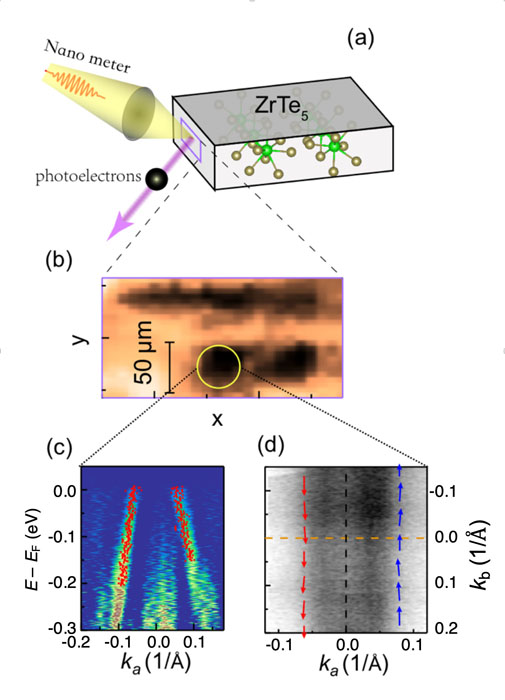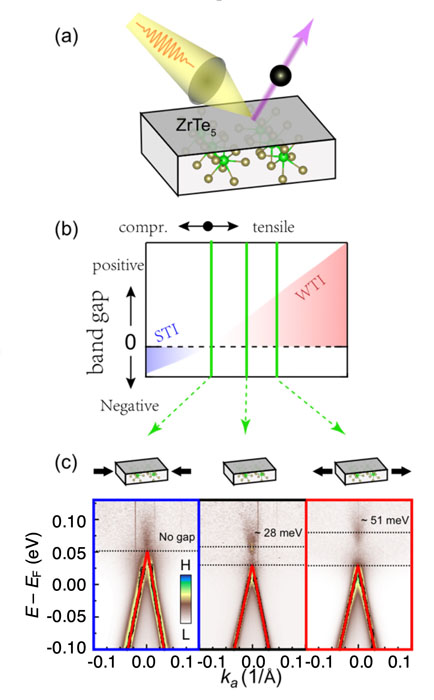Observation and Control of the Weak Topological Insulator State in ZrTe5
Kondo Group
A quantum spin Hall insulator hosts topological states at the one-dimensional (1D) edge, along which backscattering by nonmagnetic impurities is strictly prohibited. Its 3D analogue, a weak topological insulator (WTI), possesses similar quasi-1D topological states confined at side surfaces. The enhanced confinement could provide a route for dissipationless current and better advantages for applications relative to strong topological insulators (STIs) [1]. However, the topological side surface is usually not cleavable and is thus hard to observe.
ZrTe5 was predicted to be a WTI candidate at the early stage of exploring WTIs [2]. This compound exhibits very high mobility, thus it has been regarded as a promising platform for devices. Nonetheless, the topological property of ZrTe5 has not been experimentally identified to date because the observation of band structure on the side surface has not been successful so far. All the previous surface-sensitive studies were carried out on the top surface, which only confirms the lack of surface states; whether or not this material is topological, therefore, has not been determined beyond speculation. Another difficulty for this study is that ZrTe5 is in proximity to multiple topological phases, whereas this feature could bring an attractive functionality of controlling bulk topology by fine-tuning a physical parameter.
In this study, we visualize the topological states of ZrTe5 by spin- and angle- resolved photoemission spectroscopy (ARPES): a quasi-1D band with spin-momentum locking was revealed on the side surface. We further demonstrate that the bulk band gap is controlled by external strain, realizing a more stable WTI state or an ideal Dirac semimetal (DS) state. The highly directional spin-current and the tunable band gap in ZrTe5 will provide an excellent platform for applications [3].
ZrTe5 has a quasi-1D crystal structure. In principle, it should be possible to cleave both top and side surfaces. Along the lattice b direction, the layers are stacked by van der Waals forces, and a clean surface can be easily obtained by cleavage. Instead, Te–Te bonding exists between adjacent layers along the lattice c direction, causing much more difficulty in cleaving the side a-b surface. In this work, we successfully cleaved the side a-b surface with a top post and silver epoxy. The problem, however, is that the cleaved areas are very small and inhomogeneous. With a synchrotron-based nano-ARPES (spot size < 1 μm), we took real space maps of photoemission intensity on several samples, as sketched in Fig. 1(a). It is found that the typical dimension of cleaved areas is around or smaller than 50 μm (Fig. 1(b)).

Fig. 1. ARPES measurements with nano-ARPES on the side surface. (a) Schematic of the experimental setup. (b) Real space intensity mapping with nano- ARPES. The signal is clear only within an area of 50 μm. (c) Band structure along the chain direction. The hole-like band is one of the topological surface band. (d) Fermi surface of the surface band in (c). Its spin-texture is indicated by red and blue arrows.
In k-space, a quasi-1D Fermi surface is exhibited by plotting ARPES intensities about the Fermi level, which shows no dispersion along lattice b direction (Fig. 1(d)). Along the lattice a direction, the band shows a hole-like dispersion (Fig. 1(c)). With different photon energies (74 eV and 7 eV), we did not find any change for this band, which support its surface origin (no kz dispersion). For the topological surface state, spin polarization is expected. To confirm this, we have used spin-resolved ARPES to check the spin texture of the surface band. A clear spin polarization is detected along the lattice b direction. In contrast, the spin polarization is almost zero along the lattice a and c directions, as indicated by red and blue arrows in Fig. 1(d). Therefore, the band is spin-polarized along the b-direction with spin-momentum locking, consistent with the spin-texture of WTIs with a quasi-1D dispersion.
On the top surface (Fig. 2(a)), we observe a small bulk gap (~ 28 meV), as shown in the middle panel of Fig. 2(c), which indicates that the WTI state in ZrTe5 is protected only marginally from external perturbations. Theoretical calculations proposed that the band gap changes with external strain. Thus, we further designed a strain device and checked the strain dependence of band structure in ZrTe5. Both compressive strain and tensile strain are applied along the chain direction of ZrTe5. The band structures under different strains are displayed in Fig. 2(c). The sample with no strain shows a band gap of ~28 meV. With tensile strain, the band gap is enlarged to ~ 51 meV. In contrast, we could reduce the band gap by compressive strain, even realizing a Dirac semimetal state with no band gap. In Fig. 2(b), we summarized the topological phases of ZrTe5 with different strains.
Our results demonstrate the existence and tunability of the WTI states in ZrTe5. The spin-momentum locked quasi-1D surface states and the strain-tunable bulk gap make ZrTe5 an ideal platform for 2D devices and spin engineering.
References
- [1] R. Noguchi et al., Nature, 566, 518 (2019).
- [2] H. Weng, X. Dai, and Z. Fang, Phys. Rev. X 4, 011002 (2014).
- [3] P. Zhang et al., Nature Commun. 12, 406 (2021).
- Authors

